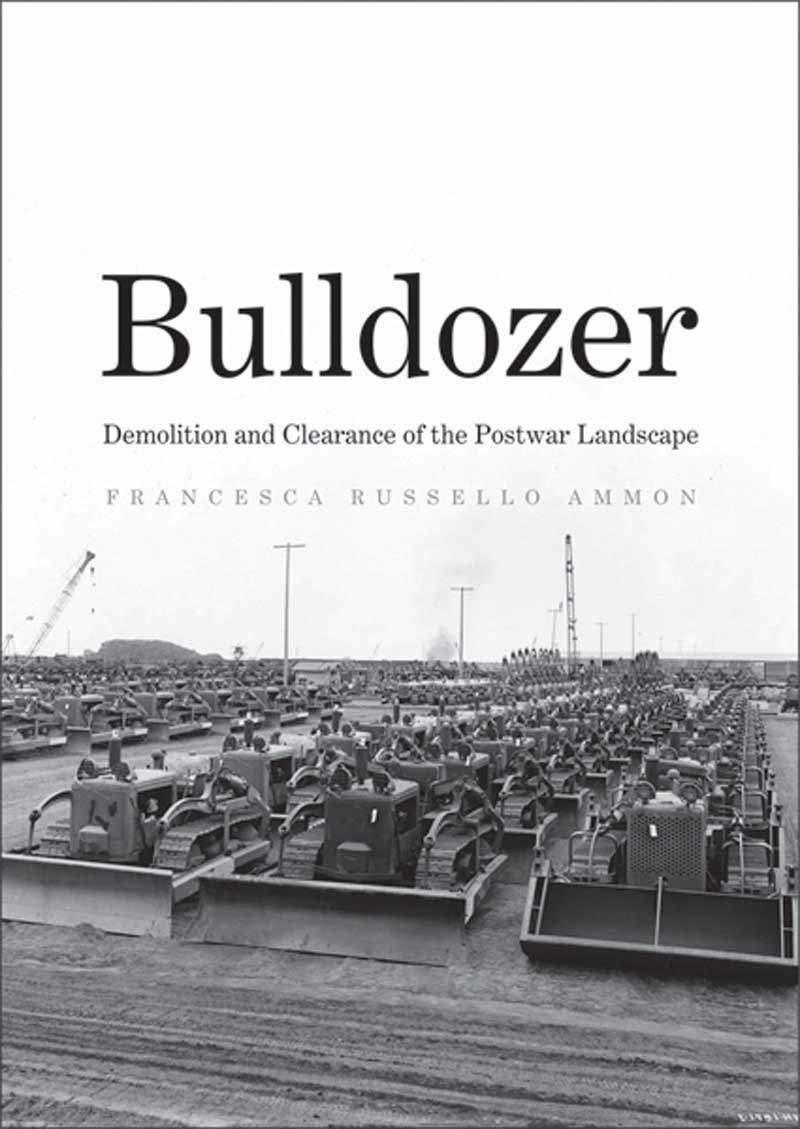HB:
37.50 GBP
QTY:
Categories:
Bulldozer
Demolition and Clearance of the Postwar Landscape
Although the decades following World War II stand out as an era of rapid growth and construction in the United States, those years were equally significant for large-scale destruction. In order to clear space for new suburban tract housing, an ambitious system of interstate highways, and extensive urban renewal development, wrecking companies demolished buildings while earthmoving contractors leveled land at an unprecedented pace and scale. In this pioneering history, Francesca Russello Ammon explores how postwar America came to equate this destruction with progress. The bulldozer functioned as both the means and the metaphor for this work. As the machine transformed from a wartime weapon into an instrument of postwar planning, it helped realize a landscape-altering "culture of clearance". In the hands of the military, planners, politicians, engineers, construction workers, and even children's book authors, the bulldozer became an American icon. Yet social and environmental injustices emerged as clearance projects continued unabated. This awareness spurred environmental, preservationist, and citizen participation efforts that have helped to slow, though not entirely stop, the momentum of the postwar bulldozer.
About the author
Francesca Russello Ammon is assistant professor of city and regional planning and historic preservation at the University of Pennsylvania. She studies the history of the built environment, focusing on the social, material, and cultural life of cities in the twentieth-century United States. She lives in Philadelphia, PA.
Reviews
"An excellent and enjoyable history of the transformation of the bulldozer from military weapon to instrument of urban planning" – Jo Guldi, Brown University
"The bulldozer! How obvious! But no one before Francesca Ammon realized that the biography of this protean machine was the royal road to an illuminating understanding of Schumpeter's 'creative destruction' of capitalism. An inspired topic, a perfect metaphor for effacing the past and engineering the future. Carried out with dash, breadth, attention to symbolism, technical knowledge, and attention to historical detail. The difference between Baron Haussmann's Paris and Robert Moses's New York is that Moses had the bulldozer and dynamite and Haussmann did not" – James C. Scott, Yale University
"Ammon has found an original topic of wide appeal. Her creative and multi-faceted approach leads her to countless new, deeply engrossing discoveries about the history of clearing, building, and rebuilding in the mid-20th century" – Alison Isenberg, Princeton University
"In this original and incisive book, Ammon shows that machines and methods developed for warfare remade American landscapes and cities after World War II" – Edmund Russell, author of "War and Nature: Fighting Humans and Insects with Chemicals from World War I to Silent Spring"
"Strikingly original and thoroughly engaging, Bulldozer shows how an adulation of destruction-as-opportunity, honed during World War II, became deeply engrained in postwar American visual culture and the design politics of urban, suburban, and superhighway development. By viewing the bulldozer as both machine and mindset, Ammon reveals the fascinating confluence of celebratory staging and complex environmental and social loss" – Lawrence J. Vale, author of "Purging the Poorest: Public Housing and the Design Politics of Twice-Cleared Communities"
"Ammon recovers the military, economic, and artistic importance of the American bulldozer from World War II to the present, combining in her exemplary study oral history, popular culture, and archival work. Bulldozers were transformative machines, whether charging up the beach at D-Day, reshaping land for highways and suburbs, reclaiming damaged spaces, or sculpting earthworks of devastating grandeur" – David E. Nye, author of "American Technological Sublime"
"The bulldozer! How obvious! But no one before Francesca Ammon realized that the biography of this protean machine was the royal road to an illuminating understanding of Schumpeter's 'creative destruction' of capitalism. An inspired topic, a perfect metaphor for effacing the past and engineering the future. Carried out with dash, breadth, attention to symbolism, technical knowledge, and attention to historical detail. The difference between Baron Haussmann's Paris and Robert Moses's New York is that Moses had the bulldozer and dynamite and Haussmann did not" – James C. Scott, Yale University
"Ammon has found an original topic of wide appeal. Her creative and multi-faceted approach leads her to countless new, deeply engrossing discoveries about the history of clearing, building, and rebuilding in the mid-20th century" – Alison Isenberg, Princeton University
"In this original and incisive book, Ammon shows that machines and methods developed for warfare remade American landscapes and cities after World War II" – Edmund Russell, author of "War and Nature: Fighting Humans and Insects with Chemicals from World War I to Silent Spring"
"Strikingly original and thoroughly engaging, Bulldozer shows how an adulation of destruction-as-opportunity, honed during World War II, became deeply engrained in postwar American visual culture and the design politics of urban, suburban, and superhighway development. By viewing the bulldozer as both machine and mindset, Ammon reveals the fascinating confluence of celebratory staging and complex environmental and social loss" – Lawrence J. Vale, author of "Purging the Poorest: Public Housing and the Design Politics of Twice-Cleared Communities"
"Ammon recovers the military, economic, and artistic importance of the American bulldozer from World War II to the present, combining in her exemplary study oral history, popular culture, and archival work. Bulldozers were transformative machines, whether charging up the beach at D-Day, reshaping land for highways and suburbs, reclaiming damaged spaces, or sculpting earthworks of devastating grandeur" – David E. Nye, author of "American Technological Sublime"


